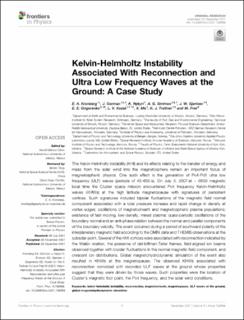| dc.contributor.author | Kronberg, E.A. | |
| dc.contributor.author | Gorman, J. | |
| dc.contributor.author | Nykyri, K. | |
| dc.contributor.author | Smirnov, Artem | |
| dc.contributor.author | Gjerløv, Jesper | |
| dc.contributor.author | Grigorenko, Elena | |
| dc.contributor.author | Kozak, L.V. | |
| dc.contributor.author | Ma, Xuanye | |
| dc.contributor.author | Trattner, K.J. | |
| dc.contributor.author | Friel, M. | |
| dc.date.accessioned | 2022-03-11T14:26:38Z | |
| dc.date.available | 2022-03-11T14:26:38Z | |
| dc.date.created | 2022-02-06T14:53:32Z | |
| dc.date.issued | 2021 | |
| dc.identifier.issn | 2296-424X | |
| dc.identifier.uri | https://hdl.handle.net/11250/2984738 | |
| dc.description.abstract | The Kelvin-Helmholtz instability (KHI) and its effects relating to the transfer of energy and mass from the solar wind into the magnetosphere remain an important focus of magnetospheric physics. One such effect is the generation of Pc4-Pc5 ultra low frequency (ULF) waves (periods of 45–600 s). On July 3, 2007 at ∼ 0500 magnetic local time the Cluster space mission encountered Pc4 frequency Kelvin-Helmholtz waves (KHWs) at the high latitude magnetopause with signatures of persistent vortices. Such signatures included bipolar fluctuations of the magnetic field normal component associated with a total pressure increase and rapid change in density at vortex edges; oscillations of magnetosheath and magnetospheric plasma populations; existence of fast-moving, low-density, mixed plasma; quasi-periodic oscillations of the boundary normal and an anti-phase relation between the normal and parallel components of the boundary velocity. The event occurred during a period of southward polarity of the interplanetary magnetic field according to the OMNI data and THEMIS observations at the subsolar point. Several of the KHI vortices were associated with reconnection indicated by the Walén relation, the presence of deHoffman-Teller frames, field-aligned ion beams observed together with bipolar fluctuations in the normal magnetic field component, and crescent ion distributions. Global magnetohydrodynamic simulation of the event also resulted in KHWs at the magnetopause. The observed KHWs associated with reconnection coincided with recorded ULF waves at the ground whose properties suggest that they were driven by those waves. Such properties were the location of Cluster’s magnetic foot point, the Pc4 frequency, and the solar wind conditions. | en_US |
| dc.language.iso | eng | en_US |
| dc.publisher | Frontiers Media | en_US |
| dc.rights | Navngivelse 4.0 Internasjonal | * |
| dc.rights.uri | http://creativecommons.org/licenses/by/4.0/deed.no | * |
| dc.title | Kelvin-Helmholtz Instability Associated With Reconnection and Ultra Low Frequency Waves at the Ground: A Case Study | en_US |
| dc.type | Journal article | en_US |
| dc.type | Peer reviewed | en_US |
| dc.description.version | publishedVersion | en_US |
| dc.rights.holder | Copyright 2021 Kronberg, Gorman, Nykyri, Smirnov, Gjerloev, Grigorenko, Kozak, Ma, Trattner and Friel | en_US |
| dc.source.articlenumber | 738988 | en_US |
| cristin.ispublished | true | |
| cristin.fulltext | original | |
| cristin.qualitycode | 1 | |
| dc.identifier.doi | 10.3389/fphy.2021.738988 | |
| dc.identifier.cristin | 1998231 | |
| dc.source.journal | Frontiers in Physics | en_US |
| dc.identifier.citation | Frontiers in Physics. 2021, 9, 738988. | en_US |
| dc.source.volume | 9 | en_US |

